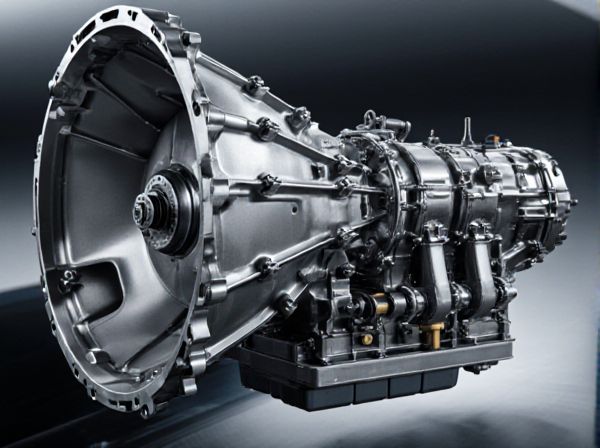
Photo illustration: Single-clutch Automated Manual Transmission vs Dual-clutch Automated Transmission
Single-clutch automated manual transmissions offer simpler mechanics and lower cost but can result in slower gear shifts and less smoothness compared to dual-clutch systems. Dual-clutch automated transmissions provide faster, seamless gear changes and improved driving performance by using two separate clutches for odd and even gears. Your choice depends on whether you prioritize affordability and simplicity or enhanced driving dynamics and efficiency.
Table of Comparison
| Feature | Single-clutch Automated Manual Transmission (AMT) | Dual-clutch Automated Transmission (DCT) |
|---|---|---|
| Gear Mechanism | One clutch engages/disengages gears sequentially | Two clutches alternate for odd/even gear sets |
| Shift Speed | Slower shifts with noticeable delay | Faster, near-seamless gear changes |
| Driving Experience | Occasional jerks during gear changes | Smoother, sportier performance |
| Fuel Efficiency | Moderate efficiency due to clutch engagement lag | Better fuel economy with optimized shifting |
| Maintenance | Lower cost, simpler design | Higher cost, complex system |
| Common Use | Economy cars, budget models | Performance vehicles, premium cars |
Introduction to Automated Transmissions
Automated transmissions enhance driving convenience by automating gear shifts, eliminating the need for manual clutch operation. Single-clutch automated manual transmissions (AMTs) use one clutch to engage and disengage gears, offering cost-effective solutions with simpler mechanics but slower shift times and occasional jerkiness. Dual-clutch automated transmissions (DCTs) employ two separate clutches for odd and even gears, enabling faster, smoother gear changes and improved fuel efficiency, commonly found in performance and luxury vehicles.
What is a Single-clutch Automated Manual Transmission?
A Single-clutch Automated Manual Transmission (AMT) combines a traditional manual gearbox with an automated clutch and gear shift system, eliminating the need for a clutch pedal and manual gear changes. This system uses actuators and sensors to operate the clutch and shift gears based on driving conditions, offering improved fuel efficiency and lower production costs compared to dual-clutch systems. While AMTs provide smoother gear shifts than manual transmissions, they generally have slower shift times and less overall performance refinement than Dual-clutch Automated Transmissions (DCT).
Understanding Dual-clutch Automated Transmission
Dual-clutch Automated Transmission (DCT) employs two separate clutches for odd and even gear sets, enabling seamless and rapid gear shifts with minimal power interruption. This design enhances acceleration, fuel efficiency, and driving smoothness compared to Single-clutch Automated Manual Transmission (AMT), which relies on a single clutch and typically experiences slower, less smooth shifts. The dual-clutch system's ability to pre-select gears results in superior performance, making it a preferred choice in high-performance and modern passenger vehicles.
Key Differences Between Single-clutch and Dual-clutch Systems
Single-clutch automated manual transmissions use one clutch to engage and disengage gears sequentially, leading to occasional gear-shifting delays and less smooth transitions. Dual-clutch automated transmissions feature two separate clutches for odd and even gears, enabling faster, seamless gear changes and improved acceleration performance. The dual-clutch system typically enhances fuel efficiency and driving dynamics compared to the single-clutch setup due to its continuous power delivery during shifts.
Performance Comparison: Acceleration and Shifting Speed
Dual-clutch automated transmissions (DCT) outperform single-clutch automated manual transmissions (AMT) in acceleration and shifting speed due to their ability to pre-select the next gear, enabling near-instantaneous gear changes. Single-clutch AMTs experience slight delays during clutch engagement and gear shifts, resulting in less seamless power delivery and slower acceleration times. Performance metrics show that vehicles equipped with DCTs often achieve faster 0-60 mph times and improved responsiveness compared to those with single-clutch AMTs.
Fuel Efficiency: Single-clutch vs Dual-clutch
Single-clutch automated manual transmissions (AMTs) generally offer better fuel efficiency due to their simpler design and lower weight compared to dual-clutch automated transmissions (DCTs). DCTs provide smoother and faster gear shifts, improving performance but often at the expense of higher fuel consumption because of increased mechanical complexity and energy loss. Studies show that while dual-clutch systems excel in sporty driving scenarios, single-clutch AMTs are more economical for everyday commuting with consistent fuel savings.
Driving Experience and Comfort
Single-clutch Automated Manual Transmissions (AMTs) often produce noticeable gear shifts and slight delays, impacting smoothness and comfort during city driving. Dual-clutch Automated Transmissions (DCTs) provide faster, seamless gear changes with minimal torque interruption, enhancing acceleration and overall driving refinement. DCTs typically offer a more engaging and comfortable experience, especially in stop-and-go traffic and sporty driving conditions.
Maintenance and Long-term Reliability
Single-clutch Automated Manual Transmissions (AMTs) generally require less complex maintenance but can experience quicker wear on the clutch components due to frequent engagement and disengagement, leading to potential replacement around 50,000 to 70,000 miles. Dual-clutch Automated Transmissions (DCTs) offer smoother shifts and improved fuel efficiency but demand more specialized maintenance, including regular fluid changes and monitoring of dual clutch packs, which can be costly after 80,000 to 100,000 miles. Long-term reliability of DCTs often surpasses AMTs when properly maintained, though neglecting maintenance can result in expensive repairs linked to mechatronic control units and clutch wear.
Cost Considerations: Initial and Ongoing Expenses
Single-clutch automated manual transmissions generally have lower initial costs due to simpler design and fewer components, making them more affordable for budget-conscious buyers. Dual-clutch automated transmissions involve higher upfront expenses because of their complex mechanisms and advanced technology, but they often deliver better fuel efficiency and smoother gear shifts, potentially reducing long-term fuel and maintenance costs. Ongoing expenses for single-clutch systems can increase due to more frequent clutch replacements, while dual-clutch systems, although pricier to repair, usually require less frequent servicing.
Which Transmission is Right for You?
Single-clutch automated manual transmissions offer cost-effective performance and simpler maintenance, making them ideal for budget-conscious drivers who prioritize fuel efficiency and straightforward operation. Dual-clutch automated transmissions provide faster gear shifts and smoother acceleration, better suited for enthusiasts seeking enhanced driving dynamics and quicker response times. Choosing the right transmission depends on your driving preferences, whether you value affordability and efficiency or sporty performance and seamless gear changes.
 caratoz.com
caratoz.com